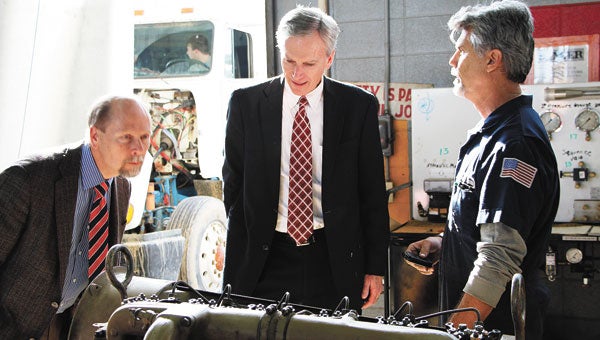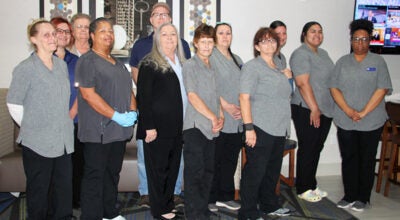Heinrich: Dual enrollment helps build workforce
Published 12:00 am Tuesday, February 25, 2014

Alabama Community College System Chancellor Dr. Mark Heinrich, center, with LBWCC President Dr. Herb Riedel, and Eddie Spann, diesel and heavy equipment mechanics program faculty.
Courtesy photo
Dual enrollment was paramount on the mind of Dr. Mark Heinrich, chancellor of the Alabama Community College System, when he spoke Monday to the Andalusia Kiwanis Club.
“Workforce development has become the buzzword of the day,” Heinrich told Kiwanis members, calling dual enrollment for high school students a great tool in filling the current and coming gaps in the state’s workforce.
“All education is workforce development,” Heinrich said, adding the need for both “craftspeople” and workers from the academic side of study is increasing as baby boomers retire.
“You talk to employers and they’ll tell you nearly 50 percent of their workforce could retire today,” Heinrich said. “And as the economy improves, more people are going to retire, because they feel more confident about entering the next phase of their lives.”
Heinrich said filling to the gap in trained workers begins in high school, where students in public institutions may elect to take college-level courses and ultimately graduate with a diploma, as well as an associate’s degree.
“These credits will transfer to any two-year college or university in the state,” he said. “It is happening at an increasing rate in our state.”
Heinrich pointed to the Alabama legislature as key in continuing the success of dual enrollment programs by passing pertinent legislation, such as the Alabama Future Workforce Initiative currently making its way through the statehouse in Montgomery.
“If the legislature can push these bills through, it means more dual enrollment money,” Heinrich said. “Last year, we were $2 million short in scholarship funds.”
The initiative, proposed by House Republicans and co-sponsored by Rep. Alan Baker of Brewton, would create a $10 million scholarship fund for dual enrollment programs in state high schools.
LBW Community College president Dr. Herb Riedel previously told The Star-News that the college must apply for grant funding every year for career-technical dual enrollment through the Governor’s Office of Workforce Development.
“We have received these grants regularly, but the amount varies and has not been sufficient to fund every eligible student,” he said. “In the current academic year, LBW has 85 local high school students taking career-technical dual enrollment classes. This number would have been higher, if we had not exhausted the available funding in the fall.”
Heinrich predicted as many as 800,000 job openings will need to be filled in coming years amidst a “retirement tsunami.”
“The demand is just unreal,” he said. “We understand businesses and individuals expect us to keep up with these demands and if we don’t, businesses are far less likely to come to our state.”
Currently, Heinrich said the Alabama Community College System includes 25 college and technical schools, one military school and 86 institutional sites, with 152 programs serving more than 250,000 students.




